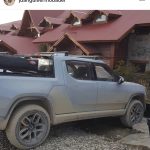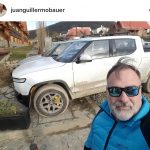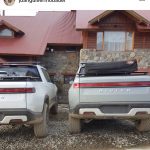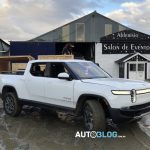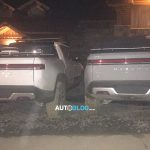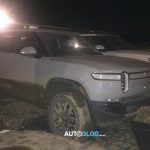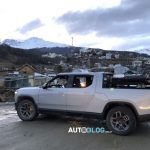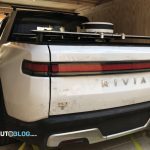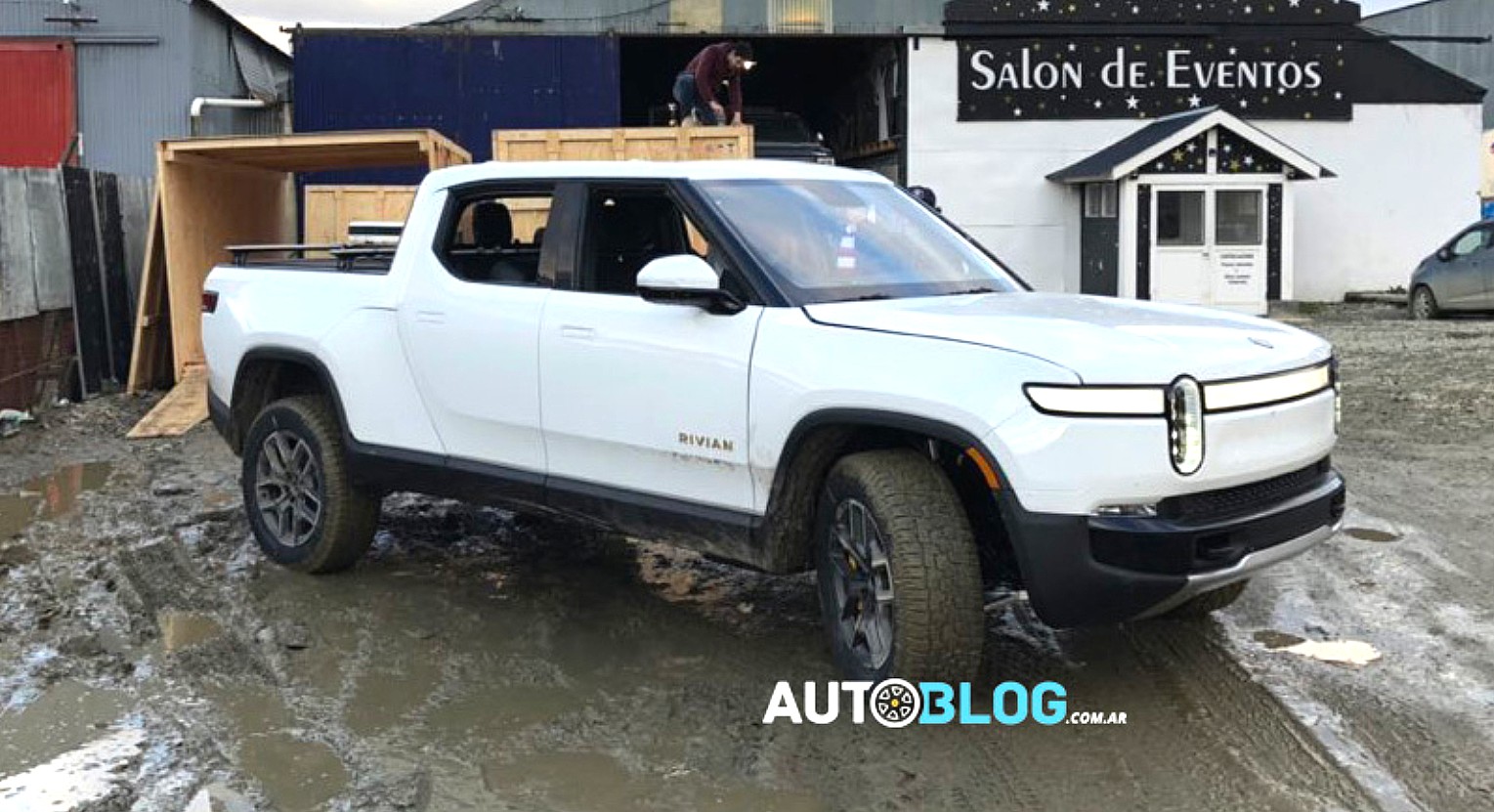
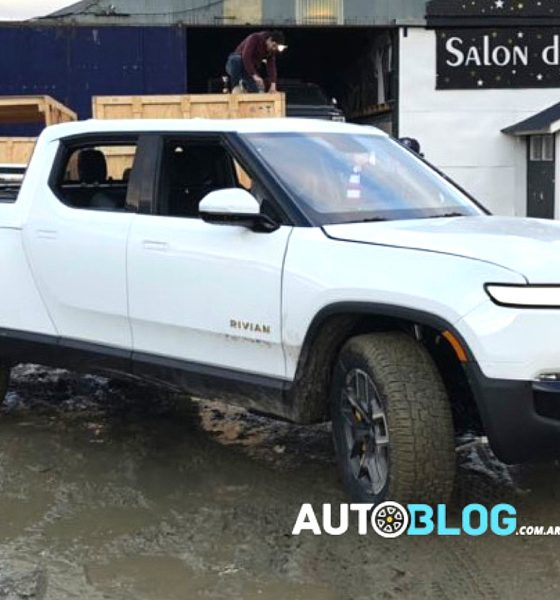
News
Rivian R1T trucks spotted in Argentina for EV adventure travel show: report
Getting a glimpse of any Rivian vehicle outside their show models is pretty rare, and even then it’s usually just a test mule with another manufacturer’s body wrap. However, Rivian fans are in for a treat this week as two additional R1T all-electric trucks were spotted in Ushuaia, Argentina.
The white-bodied pickup models recently arrived in the country and are reportedly going to be part of an adventure travel show starring Ewan McGregor and Charley Boorman. Previous projects by the duo involved trekking through various locations around the world on motorcycles, one titled Long Way Round, the other Long Way Down. This newest show will be called Long Way Up and involves electric motorcycles, specifically the Harley-Davidson LiveWire, and it will document McGregor and Boorman traveling from Argentina through Los Angeles, according to Argentinian publication Autoblog. The trip will possibly go as far as Alaska, depending on various factors.
- (Image: Juan Guillermo Bauer/Instagram)
- (Image: Juan Guillermo Bauer/Instagram)
- (Image: Juan Guillermo Bauer/Instagram)
- (Image: Juan Guillermo Bauer/Instagram)
Rivian R1T pickup trucks spotted in Argentina. (Credit: Juan Guillermo/Instagram)
A few new R1T features seen were noted by RivianForums user jimcgov3 who posted images of the truck originally from Juan Guillermo Bauer’s Instagram side-by-side with Rivian’s images. First, the two models seen in Argentina appear to be prototype models vs. the show models specifically described as what the R1T will look like in final production by various Rivian team members. The one photo showing the inside of the truck’s cabin has generic buttons throughout both the steering wheel and the center console. Next, the charge port on the vehicle is on the driver’s side after being on the passenger’s side in Rivian’s concept images. Tow hooks have also been added to the front bumper, and the “Black Mountain” interior coloring seems to be appearing for the first time. Finally, an R1T tailgate logo looks to have made its debut for the long trip.
Dos pick-ups Rivian RT1 (100% eléctricas) llegaron a Ushuaia para poner en marcha una travesía por toda América.
Nota, fotos y videos acá: https://t.co/jB1yZAizQw@Rivian pic.twitter.com/qVFeSGRJM1— Motor1.com Argentina (@Motor1argentina) August 31, 2019
- (Image: Autoblog Argentina)
- (Image: Autoblog Argentina)
- (Image: Autoblog Argentina)
- (Image: Autoblog Argentina)
- (Image: Autoblog Argentina)
- (Image: Autoblog Argentina)
Rivian R1T pickup trucks spotted in Argentina. (Credit: Autoblog Argentina)
A video posted by Autoblog of the R1T trucks arriving in Ushuaia had a bit of a Jurassic Park-style feel to it, tying well with Rivian CEO RJ Scaringe’s prior references to self-driving ‘Jurassic Park’ tours with their vehicles, although the lack of velociraptors in the shipments ties for both cool and uncool. It does appear that a gas-powered caravan will be following the show, but a Ford F-150 Raptor isn’t part of the crew. For the record, an F-350 will be tagging along for support as well as a few vans. Filming is said to begin next week.
As Rivian gears up for full production, a few features of the upcoming R1T have been teased as has factory progress. In July, the company’s official Twitter account touted its manufacturing progress with photos of several stamped metal frames for the truck hanging on racks inside one of their facilities. “Busy making metal!” the company posted as a caption alongside three images. Also revealed in the photos was Rivian’s logo stamped on the parts, a nod to their attention to detail.
Earlier this month, the company’s Twitter account also revealed several roof options that would be available for the R1T. “We will offer multiple roof styles including electrochromic glass (which turns from opaque to transparent on demand), a fixed glass panel, a two-piece removable composite roof and a standard fixed roof,” the company replied in response to a related question. The electrochromic roofs on the current demo R1T and R1S are controlled from the main infotainment screen, as has been shown by Rivian team members during trade and auto show appearances.

Elon Musk
Elon Musk and Tesla AI Director share insights after empty driver seat Robotaxi rides
The executives’ unoccupied tests hint at the rapid progress of Tesla’s unsupervised Robotaxi efforts.

Tesla CEO Elon Musk and AI Director Ashok Elluswamy celebrated Christmas Eve by sharing personal experiences with Robotaxi vehicles that had no safety monitor or occupant in the driver’s seat. Musk described the system’s “perfect driving” around Austin, while Elluswamy posted video from the back seat, calling it “an amazing experience.”
The executives’ unoccupied tests hint at the rapid progress of Tesla’s unsupervised Robotaxi efforts.
Elon and Ashok’s firsthand Robotaxi insights
Prior to Musk and the Tesla AI Director’s posts, sightings of unmanned Teslas navigating public roads were widely shared on social media. One such vehicle was spotted in Austin, Texas, which Elon Musk acknowleged by stating that “Testing is underway with no occupants in the car.”
Based on his Christmas Eve post, Musk seemed to have tested an unmanned Tesla himself. “A Tesla with no safety monitor in the car and me sitting in the passenger seat took me all around Austin on Sunday with perfect driving,” Musk wrote in his post.
Elluswamy responded with a 2-minute video showing himself in the rear of an unmanned Tesla. The video featured the vehicle’s empty front seats, as well as its smooth handling through real-world traffic. He captioned his video with the words, “It’s an amazing experience!”
Towards Unsupervised operations
During an xAI Hackathon earlier this month, Elon Musk mentioned that Tesla owed be removing Safety Monitors from its Robotaxis in Austin in just three weeks. “Unsupervised is pretty much solved at this point. So there will be Tesla Robotaxis operating in Austin with no one in them. Not even anyone in the passenger seat in about three weeks,” he said. Musk echoed similar estimates at the 2025 Annual Shareholder Meeting and the Q3 2025 earnings call.
Considering the insights that were posted Musk and Elluswamy, it does appear that Tesla is working hard towards operating its Robotaxis with no safety monitors. This is quite impressive considering that the service was launched just earlier this year.
Elon Musk
Starlink passes 9 million active customers just weeks after hitting 8 million
The milestone highlights the accelerating growth of Starlink, which has now been adding over 20,000 new users per day.

SpaceX’s Starlink satellite internet service has continued its rapid global expansion, surpassing 9 million active customers just weeks after crossing the 8 million mark.
The milestone highlights the accelerating growth of Starlink, which has now been adding over 20,000 new users per day.
9 million customers
In a post on X, SpaceX stated that Starlink now serves over 9 million active users across 155 countries, territories, and markets. The company reached 8 million customers in early November, meaning it added roughly 1 million subscribers in under seven weeks, or about 21,275 new users on average per day.
“Starlink is connecting more than 9M active customers with high-speed internet across 155 countries, territories, and many other markets,” Starlink wrote in a post on its official X account. SpaceX President Gwynne Shotwell also celebrated the milestone on X. “A huge thank you to all of our customers and congrats to the Starlink team for such an incredible product,” she wrote.
That growth rate reflects both rising demand for broadband in underserved regions and Starlink’s expanding satellite constellation, which now includes more than 9,000 low-Earth-orbit satellites designed to deliver high-speed, low-latency internet worldwide.
Starlink’s momentum
Starlink’s momentum has been building up. SpaceX reported 4.6 million Starlink customers in December 2024, followed by 7 million by August 2025, and 8 million customers in November. Independent data also suggests Starlink usage is rising sharply, with Cloudflare reporting that global web traffic from Starlink users more than doubled in 2025, as noted in an Insider report.
Starlink’s momentum is increasingly tied to SpaceX’s broader financial outlook. Elon Musk has said the satellite network is “by far” the company’s largest revenue driver, and reports suggest SpaceX may be positioning itself for an initial public offering as soon as next year, with valuations estimated as high as $1.5 trillion. Musk has also suggested in the past that Starlink could have its own IPO in the future.
News
NVIDIA Director of Robotics: Tesla FSD v14 is the first AI to pass the “Physical Turing Test”
After testing FSD v14, Fan stated that his experience with FSD felt magical at first, but it soon started to feel like a routine.

NVIDIA Director of Robotics Jim Fan has praised Tesla’s Full Self-Driving (Supervised) v14 as the first AI to pass what he described as a “Physical Turing Test.”
After testing FSD v14, Fan stated that his experience with FSD felt magical at first, but it soon started to feel like a routine. And just like smartphones today, removing it now would “actively hurt.”
Jim Fan’s hands-on FSD v14 impressions
Fan, a leading researcher in embodied AI who is currently solving Physical AI at NVIDIA and spearheading the company’s Project GR00T initiative, noted that he actually was late to the Tesla game. He was, however, one of the first to try out FSD v14.
“I was very late to own a Tesla but among the earliest to try out FSD v14. It’s perhaps the first time I experience an AI that passes the Physical Turing Test: after a long day at work, you press a button, lay back, and couldn’t tell if a neural net or a human drove you home,” Fan wrote in a post on X.
Fan added: “Despite knowing exactly how robot learning works, I still find it magical watching the steering wheel turn by itself. First it feels surreal, next it becomes routine. Then, like the smartphone, taking it away actively hurts. This is how humanity gets rewired and glued to god-like technologies.”
The Physical Turing Test
The original Turing Test was conceived by Alan Turing in 1950, and it was aimed at determining if a machine could exhibit behavior that is equivalent to or indistinguishable from a human. By focusing on text-based conversations, the original Turing Test set a high bar for natural language processing and machine learning.
This test has been passed by today’s large language models. However, the capability to converse in a humanlike manner is a completely different challenge from performing real-world problem-solving or physical interactions. Thus, Fan introduced the Physical Turing Test, which challenges AI systems to demonstrate intelligence through physical actions.
Based on Fan’s comments, Tesla has demonstrated these intelligent physical actions with FSD v14. Elon Musk agreed with the NVIDIA executive, stating in a post on X that with FSD v14, “you can sense the sentience maturing.” Musk also praised Tesla AI, calling it the best “real-world AI” today.
